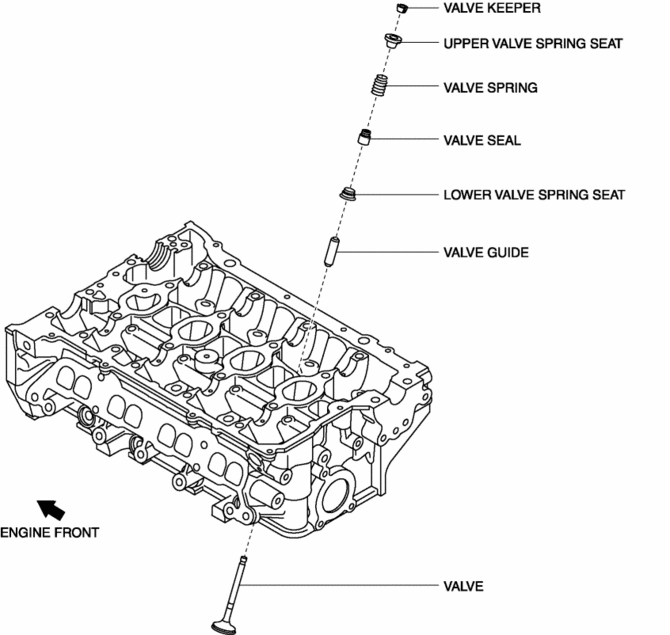Mazda CX-5 Service & Repair Manual: Valve, Valve Spring, Valve Seal, Valve Guide
Purpose, Function
Valve
-
The intake valve is pressed down by the cam, the intake air passage is opened, and air is introduced into the cylinder.
-
The exhaust valve is pressed down by the cam, the exhaust air passage is opened, and combustion gas is exhausted from the cylinder.
Valve spring
-
The valve spring adheres to the valve seat by pulling up the valve by spring force, and air tightness in the combustion chamber is maintained.
Valve seal
-
The valve seal prevents engine oil from entering combustion chamber through the valve guide, and engine oil consumption is suppressed.
Valve guide
-
The valve guide maintains the valve stem to open and close the valve smoothly.
-
The valve guide cools the valve by transmitting valve heat to the cylinder head.
Construction
-
The valve, valve spring, valve seal, and valve guide are assembled to the cylinder head as a single unit.

-
The sliding resistance has been reduced by setting the valve spring load to the required minimum.
-
The intake valve and exhaust valve are subjected to a salt-bath, soft-nitriding treatment to enhance wear resistance.
-
Unequal pitch valve spring has been adopted. In addition, the upper diameter is smaller compared to the bottom diameter.
-
The valve guide is made of sintered alloy with excellent wear resistance.
 Hydraulic Lash Adjuster, Rocker Arm
Hydraulic Lash Adjuster, Rocker Arm
Purpose, Function
HLA
The HLA maintains the valve clearance at a constant 0 mm and maintenance-free
valve clearance is realized.
Rocker arm
With the adoption of the needle roll ...
Other materials:
Engine Coolant Leakage Inspection
WARNING:
Never remove the cooling system cap or loosen the radiator drain plug while
the engine is running, or when the engine and radiator are hot. Scalding engine
coolant and steam may shoot out and cause serious injury. It may also damage
the engine and cooling system.
Tu ...
Seat
Outline
Front seat
A manual seat or power seat has been adopted on the driver's seat.
A seat warmer system has been adopted on the front seats. (with seat warmer
system)
A manual seat has been adopted on the front passenger's seat.
A side air bag module is ...
Front Side Frame Removal [Panel Replacement]
Symbol Mark
Removal Procedure
1. Drill the 15 locations indicated by (A) shown in the figure.
2. Drill the 4 locations indicated by (B) shown in the figure.
NOTE:
When drilling the 4 locations indicated by (B) shown in the figure, do not
drill a hole all the way through or there ...

